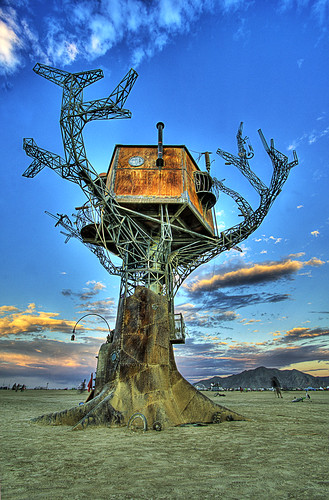Steampunk: "As a subculture, we are not the spawn of Satan"
Posted by Big Gav in bruce sterling, reversalism, steampunk
Steampunk is a literary genre I thought had pretty much died out quite a while ago - I used to read James Blaylock, Tim Powers and co in my teens, but I suspect the last time I set eyes on a steampunk novel was Gibson and Sterling's "The Difference Engine" and since then its just been the occasional bizarre piece of art flickering through the Boing Boing stream. Its basically a form of stylistic reversalism, but one which can be quite visually appealing at times.
There seems to have been a resurgence in the area lately, spawning a whole new subculture - so much so that the New York Times has reported on it - Steampunk Moves Between 2 Worlds.
It is also the vision of steampunk, a subculture that is the aesthetic expression of a time-traveling fantasy world, one that embraces music, film, design and now fashion, all inspired by the extravagantly inventive age of dirigibles and steam locomotives, brass diving bells and jar-shaped protosubmarines. First appearing in the late 1980s and early '90s, steampunk has picked up momentum in recent months, making a transition from what used to be mainly a literary taste to a Web-propagated way of life.
To some, "steampunk" is a catchall term, a concept in search of a visual identity. "To me, it's essentially the intersection of technology and romance," said Jake von Slatt, a designer in Boston and the proprietor of the Steampunk Workshop (steampunkworkshop.com), where he exhibits such curiosities as a computer furnished with a brass-frame monitor and vintage typewriter keys.
That definition is loose enough to accommodate a stew of influences, including the streamlined retro-futurism of Flash Gordon and Japanese animation with its goggle-wearing hackers, the postapocalyptic scavenger style of "Mad Max," and vaudeville, burlesque and the structured gentility of the Victorian age. In aggregate, steampunk is a trend that is rapidly outgrowing niche status.
"There seems to be this sort of perfect storm of interest in steampunk right now," Von Slatt said. "If you go to Google Trends and track the number of times it is mentioned, the curve is almost algorithmic from a year and a half ago." (At this writing, Google cites 1.9 million references.)
"Part of the reason it seems so popular is the very difficulty of pinning down what it is," Von Slatt added. "That's a marketer's dream."
Devotees of the culture read Jules Verne and H. G. Wells, as well as more recent speculative fiction by William Gibson, James P. Blaylock and Paul Di Filippo, the author of "The Steampunk Trilogy," the historical science fiction novellas that lent the culture its name. They watch films like "The City of Lost Children" (with costumes designed by Jean Paul Gaultier), "The League of Extraordinary Gentlemen" and "Brazil," Terry Gilliam's dystopian fantasy satirizing the modern industrial age; and they listen to melodeons and Gypsy strings mixed with industrial goth. ...
"As a subculture, we are not the spawn of Satan," Kriete said. "People smile when they see us. They want to take our picture."
Robert Brown, the lead singer for Abney Park, a goth band that has reinvented itself as steampunk, echoed her sentiments. "Steampunk is not dark and spooky," he said. "It's elegant and beautiful."
Even heroic, if you like. The movement may have a postapocalyptic strain, but proponents tend to cast themselves as spirited survivors. Molly Friedrich, an artist and a jewelry designer in Seattle, approaches steampunk, she said, "from a perspective of 1,000 years into the future, after society has crumbled but people have chosen to live in Victorian fashion, wearing scavenged clothes." In keeping with her vision, Friedrich has devised an alternate identity composed of petticoats, old military storm coats, goggles and aviator caps with an Amelia Earhart flair.
She takes her emotional cues from scientists and inventors like Nikola Tesla, magicians like Harry Houdini and soulful spies like Mata Hari, each of whom injected a spirit of enterprise, intrigue and discovery into their age. Contemporary fictional parallels in film include the wildly ingenious scientist played by Robert Downey Jr. in "Iron Man," who hopes to save the world by retooling himself as a flame-throwing robot made of unwieldy scrap metal parts.
If steampunk has a mission, it is, in part, to restore a sense of wonder to a technology-jaded world. "Today satellite photos make the planet seem so small," Brown lamented. "Where is the adventure it that?" In contrast, steampunk, with its airships, test tubes and time machines, is, he said, "sort of a dream , the way we used to daydream. It's like part of your childhood's just bursting forward again."
For some of its adherents, steampunk also offers a metaphoric coping device. "It has an intellectual tie to the artists and artisans dealing with a world in turmoil at the time of the industrial revolution," said Crispen Smith, a Web designer and photographer in Toronto, and a partner in a steampunk fashion business.
Sterling himself says that if the genre is in the Times, then the death of steampunk must be near.
Steampunk's in the New York Times. So the "death of steampunk" must be near. Hey wait, can the postmodern appropriation of something already "dead" actually *die*? That's like asking if people are gonna get impatient with the 10,000 year perspective of Long Now Foundation.
Bruce also suggests Bay Area residents "Join the Long Now Foundation in its determined exploration of impossibly complex, aging, steampunk mechanisms" on the Long Now Mechanicrawl.
"Spend a summer day exploring the mechanical marvels along San Francisco's North Shore! See giant running steam engines, turn of the century automata, mechanical computers, an 8 foot high mechanical planetarium and more...
"You can purchase tickets for Mechanicrawl, or join one of the participating organizations and get in free! Tickets are $15 for adults, $10 for children (under 6 are free) and $11 for students and seniors..."
"The USS Pampanito diesel electric submarine has recently completed a renovation of its Torpedo Data Computer, one of the most complex electro-mechanical computers ever put into service. The technicians involved in the renovation will be running demonstrations of the unit in the usually off-limits conning tower. Submarine veterans will be on hand to discuss other elements of the craft including an Electronic Cipher Machine, the Periscopes, Hydraulic Systems and more!"
Reason took a brief look at the NYT article and used the opportunity to point to this old interview with Sterling from 2004.
In the 1980s, Bruce Sterling became a leader of the "cyberpunk" revolution -- a literary movement that combined the artistic ambition of science fiction's 1960s New Wave with the hard-core speculation associated with Verne, Wells, Heinlein, and Clarke. Cyberpunk's chief theme was the way technologies evolve us even as we evolve them, and its influence can be seen in almost every science fiction writer of note today, from Ken MacLeod to Alastair Reynolds to Cory Doctorow.
Neuromancer author William Gibson may have been the best-known of the cyberpunks, but the movement's chief theorist and propagandist was Sterling, whose writing covered far more territory than that of his peers. Sterling's books from the period -- Schismatrix, Islands in the Net, Crystal Express -- range so widely in settings and characters that it's hard to talk about them collectively. What they have in common is their author's willingness to stare uncomfortable truths in the face. His 1989 story "We See Things Differently," for example, eerily predicted and captured the jihadic Islamism of the 9/11 era.
In the late '90s, Sterling launched another movement: the Viridian Greens. This one focused on how industrial design could be used to respond to global climate change. "Our society runs on fossil fuel," he wrote in an early manifesto. "We have a substance-abuse problem with carbon dioxide. This is a seemingly abstract issue now, but it's going to get very, very much livelier once we start having evacuation camps and dustbowls and so on. At that point, anyone who isn't talking about the Greenhouse Effect is going to seem very twentieth-century and extremely old-fashioned."
That proclamation in itself might sound old-fashioned -- not entirely out of place in a Greenpeace pamphlet -- but Sterling went on to classify his new cause as an art and design movement. He also gave it a built-in expiration date (2012). He named the movement the Viridian Greens because, as he puts it, "there's something electrical and unnatural about our tinge of green." Sterling's rhetoric is not the renunciatory language of back-to-the-land communal farmers or febrile eco-terrorists. We've made this problem, Sterling tells us, and now it's up to us to design our way out of it -- not by denying ourselves modernity but by embracing a more intelligent version of it.
Sterling is no one-note activist. His mind buzzes with ideas about history, technology, art theory, politics, global cultural trends, and more. The best introduction to the scope of Sterling's interests is his recent non-fiction book Tomorrow Now: Envisioning the Next Fifty Years (Random House). The book is to typical futurist prognostications what jazz is to a symphony: Sterling riffs on what the present tells us about the world our grandchildren will inherit. But like all the best futurists, Sterling has his eyes set on the past as well. That may explain why, even as he describes the book as "an ambitious, sprawling effort in thundering futurist punditry," he frames it on a set piece from Shakespeare -- "The Seven Ages of Man," from As You Like It. Perhaps surprisingly, the Shakespearean trope works rather well as a way of outlining the oncoming histories, comedies, and dramas we're staging for ourselves. ...
Another item generating some interest in the subject is a Steampunk anthology, reviewed by the LA Times and Cory Doctorow.
Last month, I mentioned Ann and Jeff Vandermeer's Steampunk anthology in passing, but the book deserves better than that. I've just spent several highly entertaining hours with my advance review copy and I'm knocked out. What a great piece of work this is, from the fascinating triumvirate of essays that recount the history of steampunk in literature and describe its contemporary appeal to the top-notch works of fiction inside, from forgotten proto-steampunk gems by Michael Moorcock and James Blaylock to contemporary pieces from Neal Stephenson, Jay Lake, Ted Chiang and Paul Di Filippo (among many others). Summer's almost here -- time to do some leisure reading, and what better place to start than here?
Even the Wall Street Journal is getting in on the act, with a video report inspired by the Steampunk workshop.








